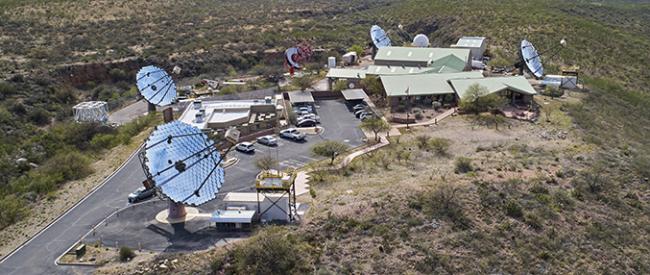Astrophysicists Once Again Seek Public's Help to Unmask Muons Disguised as Gamma Rays

Minneapolis, MN & Amado, AZ -
Muon Hunters 2: Return of the Ring, launches new Zooniverse citizen science project on March 14th, 2019.
After achieving highly successful results with their citizen science project, Muon Hunters, in 2017, scientists from the VERITAS (Very Energetic Radiation Imaging Telescope Array System) gamma-ray observatory—a part of the Center for Astrophysics | Harvard & Smithsonian at the Fred Lawrence Whipple Observatory in Amado, Arizona—collaboration are once again asking the public for help in identifying hundreds of thousands of ring patterns produced in the cameras at VERITAS.
Scientists use VERITAS to study gamma rays—the most energetic radiation in the universe—in order to explore the most exotic and extreme processes and physical conditions in space, like black holes, supernovae, and pulsars.
Like the original project, Muon Hunters 2: Return of the Ring, will engage citizen scientists to identify patterns from muons—elementary particles like electrons, but heavier—and distinguish them from those produced by gamma rays, which the telescopes are designed to detect.
"At VERITAS, we're searching for gamma rays, which have the shortest wavelengths and the highest energy of any portion of the electromagnetic spectrum," said Dr. Michael Daniel, Operations Manager, VERITAS. Muons are background that we have to get rid of so that we can more easily identify gamma rays, but they're also useful to help us calibrate our telescopes. That's where Muon Hunters, and the citizen scientists behind it, come in."
New to Muon Hunters 2 is the manner in which data will be presented to citizen scientists. Muon Hunters 2 will present images in a grid pattern, rather than individually, to bring additional efficiency to the project.
"This time around, we're trying to make both the project and the telescopes more efficient," said Dr. Lucy Fortson, University of Minnesota Physics and Astronomy Professor and VERITAS researcher. "We use a machine to help the people work more efficiently and the classifications we get from citizen scientists help the machine to work more efficiently, so it's a virtuous loop. Scientists will use the images that citizen scientists have identified to better train their computer programs to automatically tell the difference between muons and gamma rays."
Muon Hunters 2: The Return of the Ring, is run by Zooniverse, the largest online platform for collaborative volunteer research, in conjunction with VERITAS. Citizen science projects at Zooniverse allow researchers to efficiently and effectively comb through large amounts of complex data utilizing the enthusiastic efforts of millions of volunteers from around the world. Other current Zooniverse projects include Snapshot Safari, in which volunteers identify wildlife to help scientists understand the diversity and dynamics of wildlife populations across the African continent.
The original Muon Hunters project welcomed 6,107 citizen scientists who made 2,161,338 classifications of 135,000 objects. "We are hoping to have as many, if not more, classifications than we had in the original project," said Fortson. "The more data we get, the more efficient we can be, and that's great for both the scientists and the machines."
Citizen scientists can become Muon Hunters here.
About VERITAS
VERITAS (Very Energetic Radiation Imaging Telescope Array System) is a ground-based array of four, 12-m optical reflectors for gamma-ray astronomy located at the Center for Astrophysics | Harvard & Smithsonian, Fred Lawrence Whipple Observatory in Amado, Arizona. VERITAS detects gamma rays via the extremely brief flashes of blue "Cherenkov" light they create when they are absorbed in the Earth's atmosphere.
VERITAS is supported by grants from the U.S. Department of Energy Office of Science, the U.S. National Science Foundation, and the Smithsonian Institution, and by NSERC in Canada.
The VERITAS Collaboration consists of about 80 scientists from 20 institutions in the United States, Canada, Germany and Ireland.
For more information about VERITAS visit http://veritas.sao.arizona.edu
About Muon Hunters
Muon Hunters is a citizen science-based data collection and identification project led by the University of Minnesota and Zooniverse. The project receives data from VERITAS telescopes and direct support from specific VERITAS collaborating institutions including the University of California-Los Angeles; University of California-Santa Cruz; McGill University, Canada; Deutsches Electron-Synchrotron Laboratory, Berlin, Germany; Barnard College/Columbia University; Cal State University - East Bay; University College Dublin, Ireland; and the Center for Astrophysics | Harvard & Smithsonian. In addition, Muon Hunters is supported by the ASTERICS program of the European Union.
For more information about Muon Hunters, visit http://www.muonhunters.org
Headquartered in Cambridge, Mass., the Center for Astrophysics | Harvard & Smithsonian (CfA) is a collaboration between the Smithsonian Astrophysical Observatory and the Harvard College Observatory. CfA scientists, organized into six research divisions, study the origin, evolution and ultimate fate of the universe.
For more information, contact:
Dr. Lucy Fortson
Zooniverse
lffortson@gmail.com
Amy Oliver
Public Affairs
Fred Lawrence Whipple Observatory
Center for Astrophysics | Harvard & Smithsonian
amy.oliver@cfa.harvard.edu
Tyler Jump
Public Affairs
Center for Astrophysics | Harvard & Smithsonian
+1 617-495-7462
tyler.jump@cfa.harvard.edu